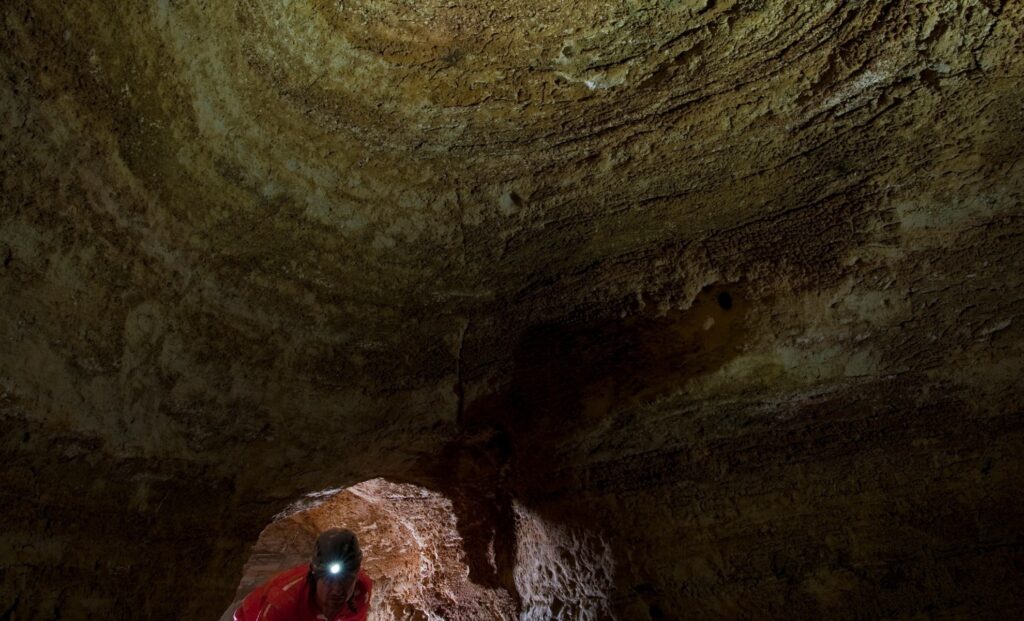Discovered by accident, Movile Cave is one of the most hostile environments on Earth—and one of the richest in unique lifeforms. Sealed off from the atmosphere, it evolved in isolation, giving rise to organisms that look more like creatures from science fiction than Earth’s surface.
For scientists, the cave offers something rare: a snapshot of life shaped entirely by extreme chemistry, not sunlight. Its alien-like ecosystem is now seen as one of the best analogs for how life might exist on other planets or moons.
Movile Cave was uncovered in 1986 during routine land surveys for a power plant. Instead of energy, the excavation revealed something far more unexpected: a hidden world where evolution took a sharp left turn. The site, located near the Black Sea, immediately drew scientific interest. Entry is difficult—only accessible via a narrow vertical shaft that drops 69 feet into a network of humid, pitch-black tunnels. Air inside is thick with carbon dioxide, methane, hydrogen sulfide, and ammonia—gases toxic to most surface life. And yet, in this chemical soup, life has not just survived—it has flourished.
A Blind World Crawling with Unique Creatures
Inside the cave’s winding 780-foot system, scientists have identified more than 170 distinct species, many of which were previously unknown to science. According to Popular Mechanics, that includes 123 species of fungi and 53 animal species, all invertebrates. Of those, 37 are found nowhere else on Earth.
These animals share striking characteristics: they’re eyeless, colorless, and often translucent. Some live in or around a groundwater-fed lake at the heart of the system. Researchers have observed spiders, leeches, nematodes, gastropods, centipedes, beetles, and tiny crustaceans—all adapted to the dark and toxic conditions.
Topping this food chain is a carnivorous, pale centipede about two inches long, dubbed the “king of the cave.” A 2020 study noted that it sits at the apex of the cave’s self-contained ecosystem. Lacking vision, creatures like this navigate using chemical cues and physical touch—tactics that make sense when light is permanently absent.

Powered by Poison, Not Sunlight
In most ecosystems, plants and algae form the base of the food chain by converting sunlight into energy. Movile Cave’s food web flips that model on its head. Here, everything depends on chemosynthesis—a process in which bacteria transform hydrogen sulfide and methane into usable organic compounds.
The cave’s floors and walls are coated in microbial mats that form the primary food source for other organisms. These bacteria thrive in 100% humidity, with barely a third of the oxygen levels present on the surface. The presence of hydrogen sulfide—responsible for the smell of rotten eggs—further indicates active chemical processes that support life, even in toxic conditions.
As Popular Mechanics explains, these gases are similar to what scientists detect around volcanic vents and geysers, not areas where we’d typically expect biodiversity. Yet this hostile mix of elements is exactly what sustains the cave’s thriving life network.


A Planetary Case Study Beneath Our Feet
The implications of Movile Cave stretch far beyond Romania. Scientists believe this hidden world offers an analog for life in the solar system—particularly on moons like Europa and Enceladus. Both are believed to host saltwater oceans beneath icy crusts, with plumes of gas and vapor suggesting active geology.
According to findings, Enceladus ejects carbon dioxide, methane, and nitrogen—gases strikingly similar to those found in Movile Cave. If microbial life can thrive in a toxic, oxygen-poor, sunless cave on Earth, it raises the possibility that similar ecosystems could exist in subsurface oceans of these distant moons.
Movile also serves as a reminder of how life may have begun on Earth itself. Many scientists theorize that the earliest organisms evolved in deep-sea hydrothermal vents under similar conditions—places with no sunlight, rich in sulfur compounds, and driven by geothermal heat.

